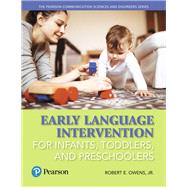NOTE: Used books, rentals, and purchases made outside of Pearson
If purchasing or renting from companies other than Pearson, the access codes for the Enhanced Pearson eText may not be included, may be incorrect, or may be previously redeemed. Check with the seller before completing your purchase.
Early Language Intervention by Robert Owens is a comprehensive text on assessment and intervention with both verbal and nonverbal communication of infants, toddlers, and preschoolers. Informative and authoritative, it offers practical guidelines for functional methods that highlight language use within the daily routines of the home and classroom. Designed as an undergraduate-level text for communication disorders students, it covers assessment an intervention of both verbal and nonverbal communication, including augmentative and alternative communication (AAC), with young children who need support in learning to communicate. Also included are valuable resources, tables, and materials particularly useful for clinicians in practice.
Improve mastery and retention with the Enhanced Pearson eText*
The Enhanced Pearson eText provides a rich, interactive learning environment designed to improve student mastery of content. The Enhanced Pearson eText is:
- Engaging. The new interactive, multimedia learning features were developed by the authors and other subject-matter experts to deepen and enrich the learning experience.
- Convenient. Enjoy instant online access from your computer or download the Pearson eText App to read on or offline on your iPad® and Android® tablet.*
- Affordable. Experience the advantages of the Enhanced Pearson eText along with all the benefits of print for 40% to 50% less than a print bound book.
*The Enhanced eText features are only available in the Pearson eText format. They are not available in third-party eTexts or downloads.
*The Pearson eText App is available on Google Play and in the App Store. It requires Android OS 3.1-4, a 7” or 10” tablet, or iPad iOS 5.0 or later.
0134509684 / 9780134300795 Early Language Intervention for Infants, Toddlers, and Preschoolers with Enhanced Pearson eText -- Access Card Package, 1e
Package consists of:
- 0134537734 / 9780134537733 Early Language Intervention for Infants, Toddlers, and Preschoolers, Enhanced Pearson eText -- Access Card, 1st Edition
- 0134618904 / 9780134618906 Early Language Intervention for Infants, Toddlers, and Preschoolers, Bound Book, 1st Edition








